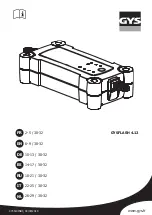
You can drive the vehicle carefully through water with a depth reaching to the bottom edge of the
body, for example puddles or shallow water. Never stop in the water, do not reverse, and never
switch off the engine.
Observe further information on driving through water on roads
⇒
Driving through water .
WARNING
Flowing water can develop enormous power and sweep the vehicle away. This can lead to very
dangerous situations which can cause accidents and serious or even fatal accidents.
Never stop the vehicle when in water.
Water in the engine compartment can cause the vehicle to break down in the water.
Soft ground surfaces, underwater obstacles and shallows can cause accidents and can cause the
vehicle to breakdown in the water. This could lead to critical situations.
NOTICE
If you drive through water, parts of the vehicle, such as the engine, drive train, running gear and
vehicle electrics, could sustain severe damage.
When driving through water, always select a section where the ground is solid and where the depth
of the water does not exceed the maximum permitted fording depth of the vehicle.
Never drive through salt, salty surfaces or salt water as salt can cause corrosion. Rinse off all
components that have been exposed to salt or salt water immediately with fresh water.
Offroad driving in snow
First read and observe the introductoryinformation and safety warnings
⇒
Introduction
Fit snow chains to the front wheels only before driving on snow-covered terrain.
Terrain might look harmless, but there could be hidden dangers. This is particularly true of sections
where there are no visible tyre tracks or other tracks.
WARNING
Driving in snow-covered terrain is very dangerous.
Both shallow and deep potholes, hollows, ditches, precipices, frozen surfaces and other obstacles
can be fully or partially covered by snow.
Dangers concealed by snow can cause an accident, serious injuries, or cause the vehicle to break
down in extreme weather conditions.
















































